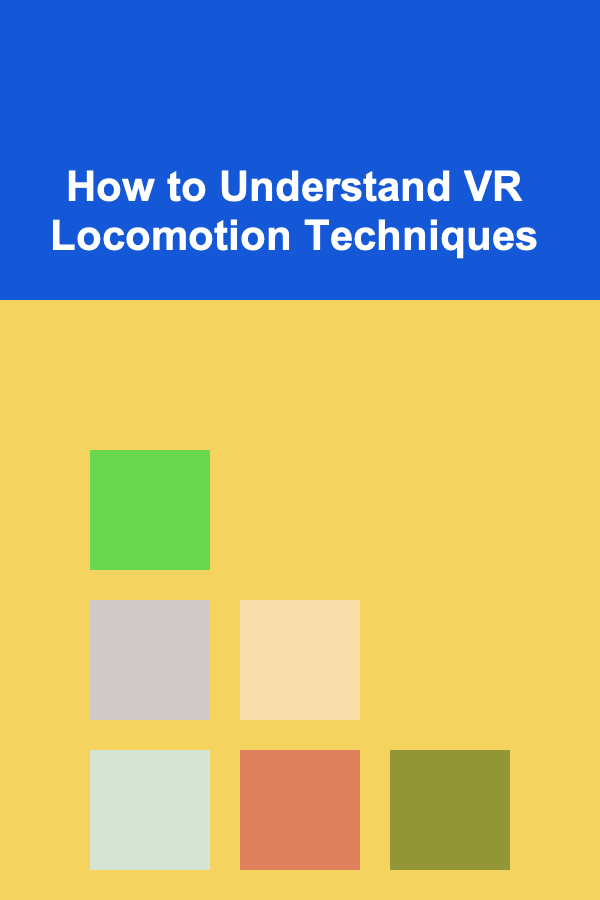
How to Understand VR Locomotion Techniques
ebook include PDF & Audio bundle (Micro Guide)
$12.99$11.99
Limited Time Offer! Order within the next:

Virtual Reality (VR) has transformed the way we interact with digital environments, creating immersive experiences that were once limited to science fiction. Central to these experiences is locomotion, the ability to navigate within a virtual world. Unlike traditional gaming or media consumption, where a user interacts through a screen and controls, VR immerses the user into the environment, and locomotion becomes critical in achieving a realistic and comfortable experience. However, VR locomotion introduces unique challenges, primarily due to the limitations of the human body and its ability to perceive movement in a digital space.
In this article, we will explore the different types of VR locomotion techniques, their challenges, their benefits, and considerations for designers and users alike. Understanding these techniques is crucial to ensuring that users can move fluidly and comfortably in VR while maintaining a sense of presence and reducing discomfort.
The Challenge of Locomotion in VR
Locomotion in VR presents a challenge because of the discrepancy between what users perceive and what their body experiences. In the physical world, when we walk, our brain receives sensory feedback from our visual, vestibular (balance), and proprioceptive (body position) systems. These systems work together to create a coherent understanding of movement.
In VR, however, users are usually standing still in a limited space while their avatar moves through a much larger virtual environment. This mismatch between visual cues (indicating movement in the VR world) and the lack of corresponding physical motion often leads to discomfort, disorientation, and motion sickness. As a result, VR locomotion techniques must be designed with these challenges in mind, ensuring that movement feels natural and doesn't overwhelm the user's senses.
Types of VR Locomotion Techniques
There are various locomotion techniques in VR, each designed to address specific challenges associated with movement. These techniques can generally be categorized into two broad groups: physical movement-based and virtual movement-based. We'll examine these techniques in detail, exploring their strengths, weaknesses, and common use cases.
2.1. Teleportation
Teleportation is one of the most popular locomotion techniques in VR, particularly in applications like games, training simulations, and social VR experiences. Teleportation allows the user to point to a location within the virtual environment and instantly transport themselves there.
How It Works
To use teleportation, the user typically points a controller or hand towards a spot in the virtual world. A visual indicator, often a glowing arc or line, shows the path to the destination. When the user releases the button, their avatar is instantly moved to that location.
Strengths:
- Comfortable: Since teleportation eliminates continuous movement, it avoids the risk of motion sickness caused by visual-vestibular conflict.
- Simple and intuitive: Users can quickly understand how to navigate in VR without requiring additional training or instruction.
- Reduced risk of disorientation: Instantaneous movement means there's little risk of becoming lost or disoriented in the virtual world.
Weaknesses:
- Less immersive: While teleportation may prevent discomfort, it can break the immersion since users are suddenly relocated in the environment, which doesn't mimic natural human movement.
- Limited fluidity: Teleportation disrupts the flow of movement, making it harder to experience continuous, natural movement.
Use Cases:
- Non-action-based VR: Ideal for experiences like VR meetings, architectural visualization, or educational simulations, where fluid movement is less important.
- Games and Exploration: Often used in games where exploration is a central feature, and players are navigating large spaces.
2.2. Walking in Place
Walking in place is a locomotion technique that simulates physical walking without requiring users to move around their physical environment. This method uses a combination of sensors, such as the VR headset and hand controllers, to detect the user's body movements and translate them into virtual motion.
How It Works
The user stands still, and the system detects their steps by tracking the movement of their feet or lower body. These virtual steps are then translated into movement within the VR world, allowing the user to "walk" without physically moving.
Strengths:
- Immersive: Walking in place feels more natural than teleportation because it simulates real-world walking, giving the user a greater sense of presence in the virtual world.
- No risk of motion sickness: Since users are mimicking physical movement, there is no disconnect between visual and sensory cues, which helps avoid motion sickness.
Weaknesses:
- Limited space: Walking in place requires enough space to move your legs, which can be difficult to achieve in a small room.
- Fatigue: Prolonged use of walking in place can be physically tiring, especially for longer sessions, which may limit its effectiveness for extended VR experiences.
Use Cases:
- Fitness VR: Commonly used in VR fitness applications, where users are encouraged to walk or jog in place to simulate movement.
- Exploration and non-violent games: Works well for experiences that involve exploration without heavy combat, where users want a more immersive feeling without intense physical exertion.
2.3. Arm Swinging
Arm swinging is another common locomotion technique that relies on the user's arm movements to simulate walking or running. The idea is that by swinging their arms as they would when walking or running, the user can move through the virtual environment.
How It Works
Using hand controllers or trackers attached to the user's body, arm swinging detects the movement of the arms in a rhythm that mimics walking or running. The system translates the arm swings into virtual movement, propelling the user through the environment.
Strengths:
- Natural and immersive: Arm swinging is a good compromise between physical movement and comfort, as it mimics natural walking without requiring full-body movement.
- Reduced motion sickness: Like walking in place, this method aligns physical movement with visual cues, reducing the chances of motion sickness.
Weaknesses:
- Limited precision: The movement can feel less precise than other techniques, and users may find it difficult to maintain control or accuracy.
- Requires significant space: Swinging arms requires ample room to avoid collisions with objects or walls, particularly in confined spaces.
Use Cases:
- Active VR games: Ideal for active games where players need to simulate running or walking without physically covering large distances.
- Fitness applications: Similar to walking in place, arm swinging is often used in fitness-focused VR games, where it encourages movement without intense physical exertion.
2.4. Joystick/Controller-based Movement
Joystick or controller-based movement is perhaps the most traditional form of locomotion in VR. Similar to how movement is handled in console or PC games, this technique allows the user to move their avatar by pressing buttons on the controller or using analog sticks.
How It Works
The user holds a controller with thumbsticks or buttons that allow them to move their avatar in the virtual environment. Depending on the controller, users may also be able to control their movement's speed, direction, and even jump or crouch.
Strengths:
- Fluid movement: This method allows users to move freely and smoothly in any direction, enhancing immersion.
- Precise control: It offers the most precision in terms of movement, especially in situations where fine control over movement is necessary, like aiming or navigating narrow spaces.
Weaknesses:
- Motion sickness: This technique is prone to causing motion sickness due to the mismatch between physical and visual movement. The user is sitting or standing still but seeing continuous movement in the VR world.
- Less natural: It requires the use of traditional controllers, which disconnects the experience from real-world physical movement.
Use Cases:
- Action-based VR games: Perfect for fast-paced games, such as shooters, where fluid, responsive movement is required.
- Exploration: Works well for applications where free movement is essential, such as 3D mapping or virtual tourism.
2.5. VR Treadmills and Omni-directional Platforms
Omni-directional platforms and VR treadmills provide a more immersive and physically active locomotion experience by allowing users to walk or run freely in any direction within a VR environment. These systems use motion tracking to detect the user's movements and translate them into virtual motion.
How It Works
These platforms are typically composed of a special surface that tracks the user's foot movements, combined with sensors to detect the user's velocity and direction. As the user walks or runs on the platform, the treadmill moves accordingly to simulate real-world walking or running within the virtual world.
Strengths:
- Highly immersive: This technique offers one of the most realistic and immersive VR locomotion experiences, as users can physically walk or run in any direction.
- Comfortable: Since the user's movements match what they see in the virtual world, it minimizes the risk of motion sickness.
Weaknesses:
- Cost: These systems are typically expensive and not widely accessible to the average consumer.
- Space requirements: These platforms require a substantial amount of physical space, making them unsuitable for many home users.
Use Cases:
- Professional VR setups: Used in high-end training, simulation, or gaming environments, such as military or flight training.
- Fitness: Perfect for creating a full-body, high-intensity workout within VR environments.
Conclusion
Understanding VR locomotion techniques is essential for both developers and users looking to create or experience the most immersive, comfortable, and effective VR environments. The technology behind locomotion continues to evolve, and with it, the possibilities for fully immersive experiences in virtual reality. Whether through teleportation, walking in place, arm swinging, joystick-based movement, or specialized hardware like VR treadmills, each technique offers unique advantages and challenges.
By considering the specific needs of the user and the design of the VR experience, it's possible to select the most appropriate locomotion technique that maximizes comfort, immersion, and overall user satisfaction. As VR technology advances, we can expect even more innovative solutions to enhance the way we move within these virtual worlds, pushing the boundaries of what is possible in digital immersion.

How to Decorate Your Home with a Small Budget for Big Impact
Read More
How to Plan a Family Puzzle Swap Night
Read More
How to Plan Seasonal Fitness Area Updates
Read More
How to Store Your Belongings Efficiently in a Small Closet
Read More
How To Succeed with Local SEO Marketing
Read More
How to Make Your Own Artisan Bread at Home
Read MoreOther Products

How to Decorate Your Home with a Small Budget for Big Impact
Read More
How to Plan a Family Puzzle Swap Night
Read More
How to Plan Seasonal Fitness Area Updates
Read More
How to Store Your Belongings Efficiently in a Small Closet
Read More
How To Succeed with Local SEO Marketing
Read More